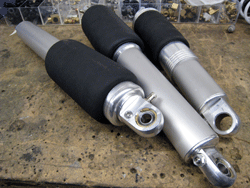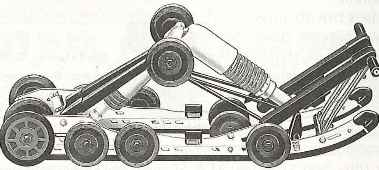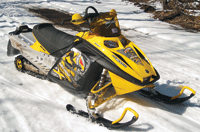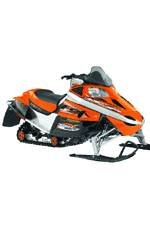We didn’t uncover any surprises when evaluating the 2007 snowmobile suspensions. The 600 HO Fusion was the sled to beat last year in the bumps, and there were no changes of mention to any of the suspension systems on these machines for 2007. But we didn’t hand the snowmobile suspension category to the 600 HO CFI IQ by default, we set out to prove it again.
We’ve called the Polaris IQ front suspension the best in the business, and some of the terrain near Munising reconfirmed it. On some of the ungroomed forest roads, the suspensions ate the moguls better than the MX Z or Nytro. Matched with the front end, the IQ rear suspension is nothing fancy with clicker shocks or exotic adjustments. But the latest from Polaris has the company’s best tricks — and it just works.
For the majority of riders, there isn’t a reason for the company to offer a more aggressive suspension package than what is available in this machine. The geometry and shock applications isolated our testers – who ranged from 155 to 190 pounds – from bumps of all sizes and at all speeds. The rear complements the front well, enabling the chassis to work well together. Bumps of every shape and size are taken with more ease than the other machines, and the IQ stays on course.
The Ski-Doo feels twitchy by comparison. There is a front-end wobble that emerges if bumps are taken from any direction other than dead-on center. It’s hard to rule it as bump steer, because the machine doesn’t want to change direction. But the wiggle movement does make it to the rider through the handlebars.
It’s easy to bottom the front torque arm on the SC-4 skid, especially on the Adrenaline model with its basic high-pressure gas shocks. The factory settings on the front were too soft for our use, so we bumped up the spring preload to the second-from-stiffest position for more resistance. It also helped out the handling for our terrain and drivers. More on that later.
The Nytro holds its own in smaller bumps when driven through rough stuff on the gas. If not, you’re eating handlebars with the strong engine braking and bounce from the torsion spring rear skid. The front end does well for soaking the bumps, and based on the stock setup of our 2006 model we used last season, we reduced the FLOAT air pressure to aid stability but it suffered a reduction in bump absorption.
The Nytro’s rear suspension is the weak link on the machine. It is capable dealing with rough trail scuttle, but not nearly as well as the other machines. The Pro Action CK rear isn’t as capable as the new rear suspension in the Phazer FX, either. Yamaha is capable of building something that works much better on rough trails and it’s already in use on another model.
On smoother trails, the Yamaha front end has consistent and predictable steering and front suspension. Handling was better with the revised air pressure that removed some of the tippy feeling in tight corners. It’s the rear suspension that doesn’t seem to know what the front end is doing.




